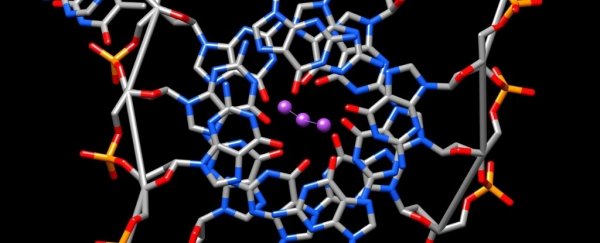The double-helix structure has practically become synonymous with DNA, but it isn't the only way long strands of genetic information squeeze themselves into a tight space.
When a double-strand of DNA doubles back on itself or attaches to another double-strand, it can actually create a quadruple-stranded knot, known as a G-quadruplex.
Scientists first discovered these 'double-double-helixes' in living human cells in 2013, and in the years since, these knots have been found in high concentrations in cancerous cells.
Now, researchers from Imperial College London have linked an accumulation of G-quadruplexes to another human disease – a rare genetic disorder known as Cockayne Syndrome (CS).
CS is a recessive condition that affects multiple systems in the body. It's characterized by premature aging, sun sensitivity, brain degeneration, and growth failure.
In most cases, the disorder is linked to a mutation in the Cockayne Syndrome B (CSB) protein, and in lab experiments involving human, insect, and bacterial cells, researchers have now shown this protein binds with "astonishing picomolar affinity" to G-quadruplexes that are formed from multiple different DNA strands.
In contrast, these proteins do not seem to bind with nearly as much affinity to double-helixes that have merely doubled back on themselves to create a four-stranded structure.
That's an important finding because it suggests the CSB protein somehow plays a role in the mixing and matching of DNA strands within the cell nucleus, specifically when it comes to ribosomal DNA.
This type of DNA holds the codes for the transcription of cellular proteins, so if the CSB protein is mutated and can no longer bind to G-quadruplexes, these proteins might never get made.
Previous experiments have shown that a lack of functional CSB tends to stall transcription of G-quadruplex structures. Without a messenger copy of this DNA, genetic information cannot leave the cell and communicate with the rest of the body.
"Given that CSB loss of function elicits premature aging phenotypes, our findings indicate that the interaction between CSB and ribosomal DNA intermolecular G4s is essential to maintain cellular homeostasis," the authors explain.
If the researchers are right, and these findings apply in the body in real-world conditions, it could mean Cockayne Syndrome leads to premature aging because it interrupts the production of proteins coded for by certain G-quadruplexes.
Most previous research on G-quadruplexes has focused on the structures that are formed when one double-helix molecule folds back on itself. But this new research is some of the first to investigate the role of G-quadruplexes that are formed from two separate double-helix molecules.
"Our genomic DNA is more than two meters long, but is compressed into a space only a few microns in diameter. It shouldn't therefore be a surprise that there are ways the long-range looped structures are leveraged to compress DNA in more complex interactions than we imagined," says chemical biologist Marco Di Antonio from Imperial College London.
"There is still so much we don't know about DNA, but our results show that how and where G-quadruplex structures form affects their function, making them more important biologically than previously thought."
The new study could ultimately help researchers come up with treatments for diseases like Cockayne Syndrome. If dysfunctional CSBs can be stopped from binding with G-quadruplexes in the first place, then perhaps this rare degenerative disorder can be mitigated in the future.
The study was published in the Journal of the American Chemical Society.
